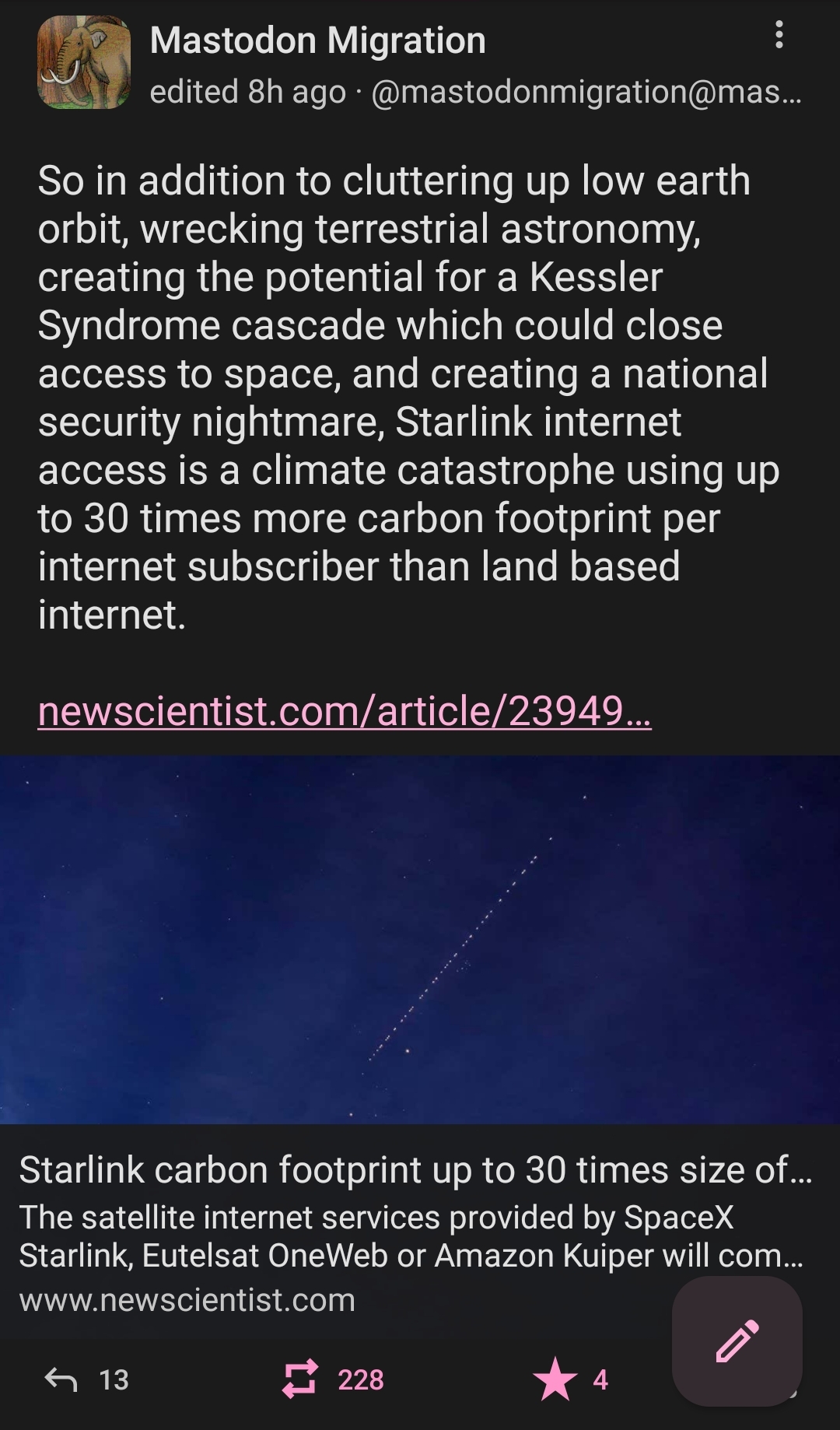this post was submitted on 08 Oct 2023
513 points (84.0% liked)
A Boring Dystopia
9719 readers
495 users here now
Pictures, Videos, Articles showing just how boring it is to live in a dystopic society, or with signs of a dystopic society.
Rules (Subject to Change)
--Be a Decent Human Being
--Posting news articles: include the source name and exact title from article in your post title
--Posts must have something to do with the topic
--Zero tolerance for Racism/Sexism/Ableism/etc.
--No NSFW content
--Abide by the rules of lemmy.world
founded 1 year ago
MODERATORS
you are viewing a single comment's thread
view the rest of the comments
view the rest of the comments

So I don't really like the idea of defending anything related to Musk, but it's kind of poor form to compare emissions between Starlink and land-based internet imo. Although they are the same product, they are targeted at completely different users, from what I understand.
Starlink should always be a more expensive and slower technology just because of communication distance, so it shouldnt really be able to compete with land-based solutions (except where telecom is reeeeeally fucking people on price). Starlink is really meant more for edge-cases where telecorps refuse to build infrastructure.
Not only this, but StarLink is a new and rapidly growing service so the number of subscribers is still on a steep upward trend. Comparing carbon/subscriber is going to be inaccurate right now due to the low number of starlink subscribers compared to a more established utility with a stable number of users. StarLink also has more new infrastructure needed than an established utility.
Use cases and costs aside, we should still be open to discussing the pros and cons of these business ventures on the planet. Musk isn't going to pay up to clean up any mess caused by this, it would be taxes and price hikes around the world in the name of going green and reducing climate impact that get paid by plebs like us.
That is not correct. The target of Starlink is satellite-to-satellite data routing in as close to a straight line as possible between point A and point B. Even adding the 500Km up and 500Km down, starting at several 1000Kms that's less distance than going through the network of ground fiber cables.
The speed of light in optic fiber cables is also only 2/3 the speed of light in vacuum (aka: space).
Starlink's end form is meant to get billions from charging intercontinental high frequency traders for a split second advantage.
Starlink isn't meant for the edge cases, the edge cases can not make it profitable. The edge cases are edge cases.
Also blotting out the sky with wasteful satalites isn't a good solution to "the free market wont build infrastructure because its broken." Its just another aspect of it being broken and the entire planet has to suffer from it.
I am not super well-researched on this, so I might be mistaken, but their market is people who don't have access to telecom infrastructure, no? I guess it's not an edge-case just because there are that many people without access? Because I don't see how they'd be able to compete on price/value with traditional internet providers.
That is not a viable market. It's far too small for the cost.
And they can't compete. It's all backed by investor money. It's the same disruption business that big tech has been doing for decades. Enter market, subsidize costs with investor money, become incumbent as everyone thinks it's such a good deal. Raise prices when there's no other option.
Uber, netflix, Spotify, same plan again. Never better, never competitive, just disruptive.
The government is also broken, the US invested billions of dollars for nation wide fiber, and it still didn't get built.
"blotting out the sky" is hyperbole and not reality. Those pics of the trains of dots in the sky are temporary and only present in the handful of days after a launch.
ah yes, the "you used flowery language to make a point and thus I'll decide that everything you said is wrong!" technique
https://www.nature.com/articles/s41586-023-06672-7.epdf?sharing_token=N9yAfmt2e_GVtwPy77HJetRgN0jAjWel9jnR3ZoTv0PFsLwdWnqlxtsKwpSN7Boq0-VZBfGQbMetAbo437Wt1qJnPYFLp9WgedI-jqcxrYcV5ukwWY9p_dhA4S6iwLOz0StMV6Cb8k8hS32gEexB7vqsPRwL1C98AnGCP-Fzu88UWpDICmoYy6v0UHlQfJmtQ7r3Hn2SM32YSSCOdCXESf8d6iCXB5WfW1SWH4zKLC0%3D
https://iopscience.iop.org/article/10.1088/1538-3873/acf40c
unfortunately Scientists have no power, so they are basically begging these companies to work with them to find solutions and the companies just aren't doing that. The best they can do is twice the maximum brightness scientists have called for, https://www.nature.com/articles/s41550-020-01238-3 estimates there could be 100,000 of these objects in the sky in the 2030s, 30x the amount we have currently.
astronomy is massively impacted by all of this, just because America refuses to build infrastructure like everyone else does, thanks America. Thanks Musk.